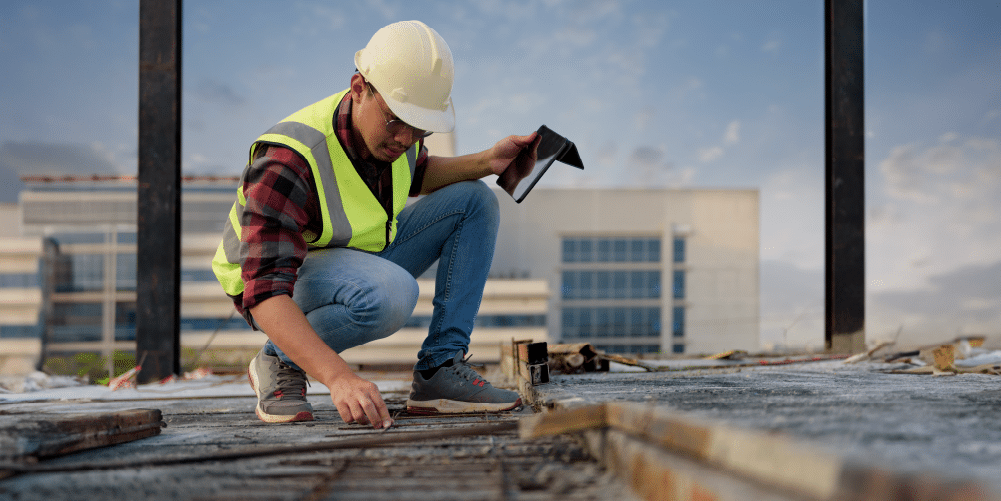Concrete is the silent hero of modern infrastructure, playing a crucial role in shaping the world around us. It forms the backbone of our homes, offices, bridges, and countless other structures that we rely on daily. This versatile material provides the durability and strength necessary to withstand the test of time and the pressures of everyday use.
However, just like any other construction material, it isn’t invincible and requires attention. Over time, factors such as weather, wear, and even unforeseen events can lead to wear and tear. Regular inspections are vital as they can help identify minor issues, like cracks or surface degradation, before they escalate into major structural problems that can result in costly repairs and safety hazards.
The Basics of Concrete Inspection
Understanding Concrete Damage
Concrete is a tough material, but it’s vulnerable to various types of damage. Common issues include cracking, spalling, and scaling. Cracking often results from stress, temperature changes, or improper curing. Spalling occurs when concrete flakes or peels away, usually due to freeze-thaw cycles or the corrosion of reinforcing steel. Scaling, on the other hand, manifests as small, shallow chips on the surface, often caused by de-icing chemicals or excess water in the mix.
Identifying Signs of Deterioration
Early identification of deterioration can save you considerable time and money. Look for discolouration, cracks, and uneven surfaces. Pay special attention to areas exposed to moisture or heavy use, as these are more prone to damage. Rust stains can indicate internal rebar corrosion, while water pooling might signify poor drainage or underlying structural issues.
Why Regular Inspection Matters
Cost-Saving Benefits of Early Detection
Regular inspection is crucial as it allows you to catch problems before they escalate, ultimately saving you a significant amount of money in the long run. Minor cracks in your structure can be filled or sealed efficiently when caught early, preventing them from widening and compromising the structural integrity of your property.
By addressing these issues promptly, you not only avoid costly repairs but also prevent potential disruptions to your property or project that could result in lost time and resources. Investing in regular inspections can lead to long-term financial benefits and peace of mind, knowing that your property is in good condition.
Enhancing Safety and Reducing Liability Risks
Safety should always be a top priority, especially in environments where people are present. Damaged concrete can pose various risks to everyone on the property, ranging from simple tripping hazards to severe structural failures that could endanger lives.
By conducting regular inspections, you can identify these risks before they escalate into accidents, significantly reducing your liability and ensuring a safer environment for all. Additionally, maintaining a safe property can enhance your reputation and foster trust among visitors, clients, or employees. Proactive measures not only protect individuals but also demonstrate your commitment to safety and responsibility.
How to Conduct a Concrete Inspection
Step-by-Step Guide for Inspecting Concrete Surfaces
Start with a visual inspection. Walk around the property and take note of any visible damage or irregularities. Next, use a hammer or a chisel to tap the surface lightly; a hollow sound can indicate voids or delamination beneath the surface. Don’t forget to check for signs of moisture, such as efflorescence or mould growth, which can weaken the concrete over time.
Tools and Technologies for Thorough Inspections
Several tools can help make your inspection more thorough. A moisture metre can detect water content within the concrete, while a Schmidt hammer assesses surface hardness. For more detailed analysis, consider using ground-penetrating radar (GPR) to identify subsurface issues like voids or rebar corrosion.
The Role of Professionals
When to use Professional Services
While basic inspections can be performed by anyone with a keen eye, certain situations require the specialised knowledge and skills of professionals. If you notice significant damage, such as large cracks in the foundation or signs of water intrusion, or if you suspect underlying structural issues that might compromise the integrity of a building, it’s best to consult a qualified expert.
Professionals possess not only the diagnostic tools but also the extensive training and experience necessary to conduct thorough assessments. They can identify potential hazards that may not be immediately apparent to the untrained eye and suggest the best course of action to ensure safety and stability.
Benefits of Professional Expertise in Maintenance
Hiring gold coast concrete scanning for maintenance tasks brings a level of expertise that can be invaluable. They are equipped to perform detailed tests, such as core sampling and petrographic analysis, which help gauge the severity and nature of the damage more accurately.
These in-depth evaluations enable professionals to formulate targeted solutions tailored to the specific issues at hand. Additionally, their recommendations are grounded in years of experience and adhere to the most current industry standards, ensuring the implementation of effective maintenance strategies.
By leveraging their knowledge, property owners can not only resolve existing problems but also prevent future complications, ultimately saving time and money in the long run.
Long-Term Strategies for Concrete Maintenance
Developing a Maintenance Plan
A good maintenance plan starts with regular inspections. Schedule these at least annually, or more frequently for high-traffic areas. Document your findings and actions taken, creating a history that helps in future assessments. Include preventive measures like sealing and waterproofing to protect against common issues.
Importance of Regular Maintenance and Inspection Schedules
Consistent maintenance is key to extending the life of your concrete structures. Regularly clean and seal surfaces to protect them from moisture and chemical exposure. Consider applying protective coatings or membranes in areas subject to heavy wear or harsh conditions. By sticking to a maintenance schedule, you can prevent minor issues from escalating into major repairs.
Conclusion
Regular concrete inspections are an essential part of property management and construction. From cost savings and enhanced safety to long-term maintenance, the benefits are clear. Prioritising these inspections can save you time, money, and stress in the long run.
Ready to take the next step? Consult with a concrete inspection professional to develop a tailored maintenance plan for your property. Their expertise can provide peace of mind and ensure the longevity of your concrete structures.








